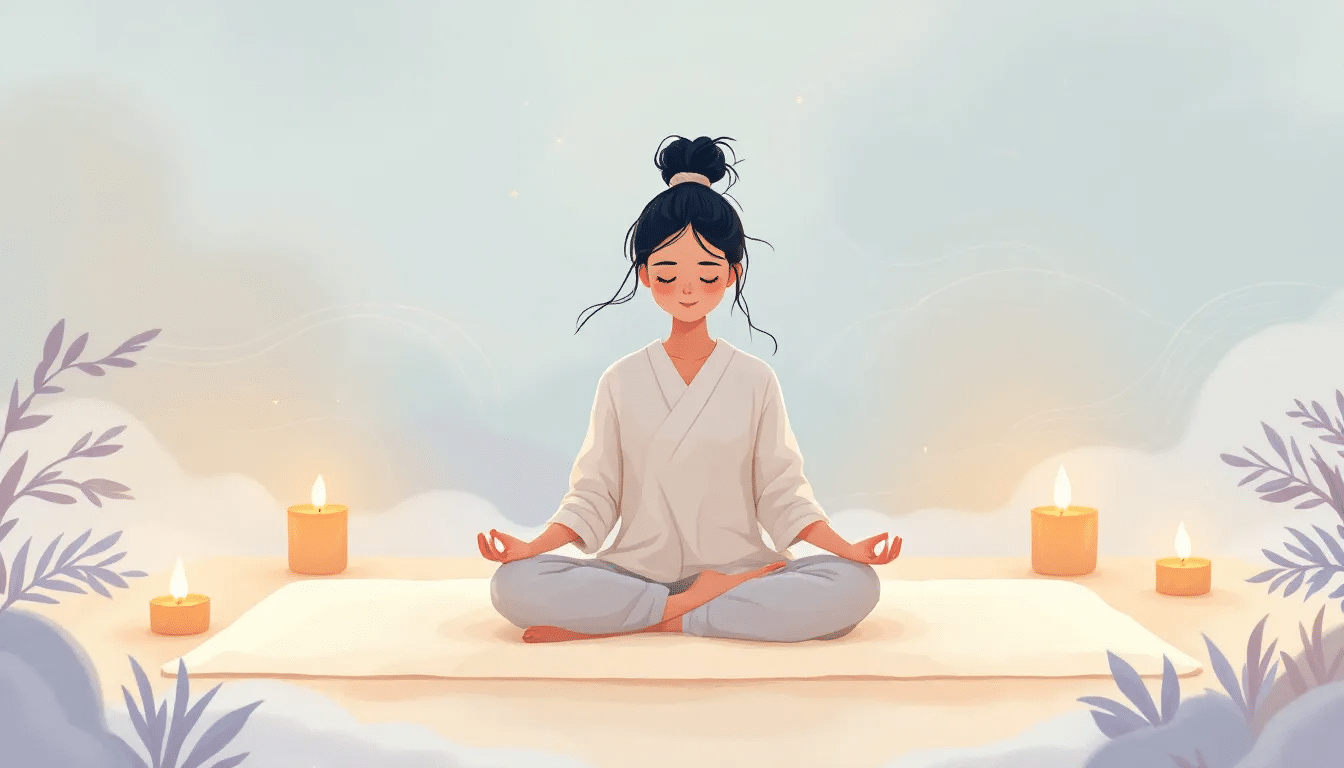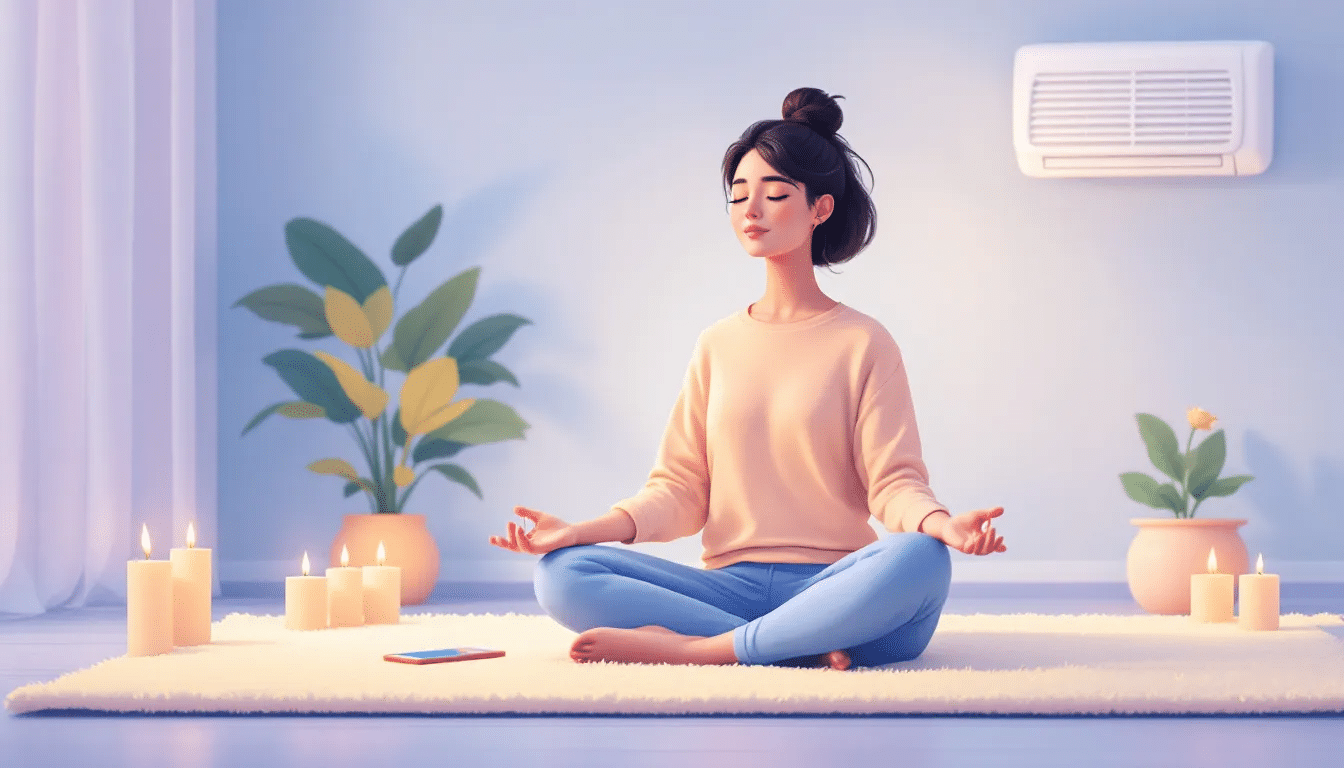When it comes to meditation, you might wonder whether GUIDED MEDITATION vs SELF MEDITATION is better for your practice. Guided meditation involves a teacher or recording directing you, while self meditation is done independently. This article will help you understand the differences, benefits, and drawbacks of both, so you can choose what works best for you.
Understanding Guided Meditation

Guided meditation is a type of meditation practice that utilizes the direction and experience of a skilled instructor to offer structured guidance. This form of meditation technique requires you to follow along with verbal cues from your guide, whose purpose is to help steer your focus and assist in mastering various meditation practices efficiently. Through guided meditations, individuals are introduced to diverse styles and techniques which aid them in identifying what resonates most effectively with their needs.
The principal advantage of engaging in guided meditations lies in its potential for facilitating deep relaxation and tranquility within both the mental and physical spheres. Guided sessions often make entering into a state of calm more accessible, particularly beneficial for newcomers embarking on the journey of learning about meditation practices.
Nevertheless, it’s crucial not to lean too heavily on these assisted forms as relying solely on them could impede personal growth within one’s practice. Ultimately, cultivating an independent approach towards your own methodical meditative routine holds significant value for achieving lasting proficiency.
Support for Beginners
Starting out with meditation can be a game-changer for novices, and guided meditation provides an essential framework that simplifies the initiation into this practice. The structured guidance provided by these sessions reduces the complexity of starting a meditation journey, which research indicates leads to higher levels of commitment in beginners than those who try meditating without guidance.
It’s important for beginners to grasp the fundamental concepts of meditation while feeling supported throughout their experience. Guided meditations serve as a valuable resource by offering clear, incremental instruction that aids learners in establishing a sturdy base from which they can progressively enhance their practice. Such support plays a pivotal role during the preliminary phase of learning, keeping individuals engaged and eager to progress on their path of practicing meditation.
Soothing Voices and Music
Incorporating calming voices and harmonious melodies into guided meditation can profoundly improve the practice. The presence of a gentle voice brings ease and steers the mind toward serenity, aiding in achieving relaxation and a tranquil state more readily. Such soothing vocal tones combined with instrumental backdrops set the stage for an environment that is ideal for profound restfulness and alleviating stress.
Experiencing guided meditation through a comforting voice proves to be exceptionally beneficial when seeking relief from stress and fostering inner peace. By sitting comfortably with closed eyes, concentrating on both the guiding voice and accompanying music permits one to release accumulated daily pressures, thereby sinking into a serene state of peace and comfort. This form of auditory assistance secures your concentration, simplifying the process to meditate effectively while promoting tranquility even amidst anxiety-induced moments—where sleep amplifies this tranquil experience.
Exploring Self Meditation

Unguided meditation, also known as self-guided meditation, involves individuals engaging in the act of meditating without external support. This approach to meditation promotes a personal journey where one can direct their focus toward breathing and select a particular point for concentration on their own. The lack of guidance paves the way for practitioners to venture into their inner landscape with greater freedom and cultivate unique techniques tailored to unguided practice.
The cornerstone of this type of meditation is its emphasis on fostering personal practice and enhancing self-awareness. When you meditate solo, it offers an opportunity to customize your technique according to your distinct needs and life conditions. Such independence not only nurtures self-reliance but also instills confidence by prompting individuals to actively manage their emotional well-being and mental health—culminating in strengthening the connection with oneself since nobody else is involved except you.
Deepening Personal Practice
Engaging in unguided meditations fosters deep reflection and often culminates in profound self-realization. When left to navigate the practice without an external voice leading them, individuals are allowed the freedom to delve into their own thoughts and emotions, which promotes a stronger sense of self-awareness and comprehension. This method of meditation that is self-directed instills confidence in one’s intuitive abilities, thereby cultivating inner resilience.
By opting for an unguided approach during meditation sessions, practitioners have the chance to undertake a more intimate journey of exploration within themselves. Embracing silence while concentrating on being present enables them to sharpen their awareness concerning their internal state, offering enlightening revelations about personal thought patterns, emotional responses, and actions. Such exploration through quiet introspection can be exceptionally enriching—potentially enhancing not only individual sessions but also strengthening future practices involving both guided and unguided meditations by making each session led by oneself.
Flexibility and Independence
Unguided meditation empowers individuals to adapt their practice according to personal preferences and life situations. The main advantage of this self-guided approach is the versatility it provides, enabling people to engage in meditation at their convenience, be it during a tranquil moment at home, amidst nature in a park or even while taking a break at the workplace. Incorporating self-meditation into one’s routine allows for its seamless inclusion within everyday activities.
By emphasizing self-initiative in unguided meditative sessions, practitioners are encouraged to take control of their mental and emotional well-being. Depending on innate abilities rather than external instruction enhances one’s capacity for self-reliance and fortitude. This autonomy can significantly contribute to overall wellness by equipping individuals with the skills necessary for effective stress management and fostering an attentive and harmonious lifestyle.
Comparing Benefits: Guided vs. Self Meditation

Both guided and unguided meditation contribute distinct advantages that serve to enrich the path of one’s meditation journey. For those just beginning, guided meditation can be incredibly supportive, offering the structure and direction needed to help them move forward with confidence in their practice. By starting with guidance, beginners are able to acquire crucial techniques and establish a robust foundation prior to moving on to self-directed or unguided meditation.
In contrast, engaging in self-guided or unguided meditations fosters a sense of independence and fortitude, inviting practitioners to delve into their inner realm without reliance on external prompts. This autonomy has the potential for leading individuals towards more profound personal discoveries and an intensified engagement with their individual experiences during meditation.
By incorporating both styles—guided as well as independent forms of mediation—into regular practice helps bolster mindfulness and amplifies self-awareness overall. Practitioners benefit from weaving together the strengths inherent in each method throughout this explorative process.
Building Confidence with Guidance
Participating in guided meditation can aid individuals in fostering genuine self-assurance by silencing internal negative dialogues. Guided sessions offer a comforting and supportive environment for novices, rendering the practice more accessible. This form of structured meditation assists participants in concentrating their attention, which minimizes distraction and improves the quality of the meditation experience.
Tailoring meditation practices to align with one’s personal desires and objectives may also amplify their impact. When practitioners adjust guided meditations to suit their unique needs and aspirations, they are likely to feel a stronger connection to the activity and achieve an enhanced sense of success. Such customization not only bolsters confidence, but also promotes ongoing participation in meditation practices.
Enhancing Inner Strength with Self Meditation
Self-directed meditation serves as a potent mechanism for fostering inner guidance and fortitude. Engaging in this practice without relying on outside prompts enables individuals to cultivate self-reliance and robustness, empowering them to trust their own intuition while independently regulating their thoughts and feelings. Such autonomy in one’s meditation journey can bolster resilience, leading to an enhanced capacity for dealing with adversities.
The competencies acquired through autonomous meditation significantly benefit mental health and contribute positively to overall well-being. This cultivation of self-awareness and independence paves the way towards achieving a more profound sense of tranquility and steadiness, thereby improving an individual’s ability to confront life’s obstacles with poise and assurance.
Potential Drawbacks of Each Approach

Both guided meditation and unassisted meditation provide a wealth of advantages, yet each has its own set of challenges. The constant directives in guided meditation may interfere with the depth of meditative practice by breaking the individual’s concentration, thereby hindering profound realizations.
Conversely, practicing self-meditation can be challenging when it comes to sustaining attention and adherence to the practice without outside guidance. This difficulty in maintaining focus can lead to exasperation and diminish the potency of the session, which some individuals might find extremely difficult to overcome.
Distractions in Guided Meditation
A significant concern with guided meditation is that persistent instructions can lead to distractions. The continuous stream of verbal prompts may hinder the practitioner’s ability to reach a deeper level of focus, thereby obstructing their path toward gaining profound realizations. Such interruptions are especially aggravating for seasoned meditators who aim for an intensive and engrossing experience during their meditative journey.
Regular guidance throughout the practice of meditation has the potential to disturb the peaceful state one achieves, challenging practitioners in sustaining both relaxation and concentrated attention. These disruptions compromise the overall impactfulness of meditation, diminishing its advantages and impeding individuals’ capacity to engage deeply with their meditative endeavor.
Challenges of Self Meditation
The practice of meditation on one’s own can be fraught with difficulties in sustaining focus and self-discipline, owing to the lack of external supervision. In the absence of a mentor offering guidance and structure, those engaged in this practice may struggle to remain concentrated. Such struggles often lead to feelings of frustration and diminish the effectiveness of their meditation endeavors. Consequently, this deficit in concentration can detract from the overall quality of the meditation experience, hindering individuals from realizing their aspirations for their meditative practices.
An individual who chooses to pursue meditation independently must exhibit considerable self-reliance and personal discipline—a daunting task, particularly for newcomers or those who find it challenging to adhere consistently to such routines. Deprived of outside signals that could bolster motivation, these practitioners are at an increased risk for discontinuing meditation altogether due to dwindling enthusiasm or resolve.
Combining Both Approaches
Incorporating both guided and independent meditation into your routine creates a comprehensive practice that capitalizes on the advantages of each method. Utilizing guided meditations can lend structure and reinforcement, augmenting the depth of solo meditation sessions and laying a robust groundwork for self-exploration. Such an integrated approach may lead to superior outcomes, empowering individuals to cultivate a more profound comprehension of their unique needs while bolstering their entire meditation journey.
Alternately, engaging in guided and unguided meditations enables one to experience the full spectrum offered by these practices. Guided exercises assist practitioners in acquiring crucial skills and techniques essential for effective practice, while personal quiet contemplation fosters introspection and self-awareness. This symbiotic blend not only boosts mindfulness, but also propels you towards a richer, more impactful path in your quest for inner peace through meditation.
Structured Guidance with Personal Exploration
Initiate your meditation journey with a guided session and then proceed to unguided meditation, effectively merging the two techniques. Utilizing this strategy offers the necessary framework and assistance for cultivating foundational abilities as well as offering opportunities for individual inquiry and introspection. Starting off with guidance assists meditators in learning how to settle peacefully into silence, while also helping them discover important self-reflections via these structured practices.
Unguided sessions enhance personal discovery by providing an environment conducive to inward listening and fostering mental clarity. The quietness amplifies one’s mindfulness of their internal experiences during practice, thereby enabling participants to acquire significant perceptions and deepen their relationship with themselves.
Tailoring Your Practice
Customizing your meditation practice to suit your unique needs and preferences can make it more powerful and enjoyable. Utilize a method like setting an interval bell, then commence with a designated meditation technique—perhaps focusing on the breath or employing a mantra. This organized strategy offers essential guidance for maintaining focus while still allowing space for individual discovery and growth.
Taking up sitting in tranquility beneath a tree or within a serene environment can also amplify the meditative experience. By shifting focus inwardly and occasionally opening one’s eyes to absorb their surroundings, practitioners are provided with five minutes to adapt, thereby becoming fully engrossed in the present moment.
Adopting such a personalized approach renders daily practice increasingly significant and efficacious, promoting heightened mindfulness and contributing positively to overall well-being.
Oraibi: A Unique Meditation Tool

Oraibi stands out as a powerful asset for enhancing one’s meditation practice, offering high-definition recordings paired with therapeutic frequencies. This distinct meditation piece is crafted and performed by the National Philharmonic Orchestra of Great Britain, creating an unparalleled auditory experience. Featuring a 174Hz frequency known to foster relaxation and ease stress, Oraibi serves as an invaluable addition to any meditative journey.
Captured within the revered walls of Abbey Road Studios, the Oraibi track boasts 3D Binaural Sound technology that envelops listeners in a deeply engaging sonic environment. Such exceptional audio quality allows practitioners to delve deeper into their meditation sessions and reap more profound benefits from their practice.
Incorporating calming vibrations along with superior sound fidelity, Oraibi emerges as an instrumental resource for those seeking mindfulness and tranquility through their reflective journey.
Healing Frequencies
Incorporating the 174Hz healing frequency, known for its restorative effects, the Oraibi track aids in achieving a more profound relaxation state. This frequency plays a significant role in soothing both mind and body by diminishing stress and physical or emotional strain. It encourages muscle relaxation and contributes to reducing breathing pace, helping alleviate discomfort.
Engaging with the Oraibi meditation piece that features this particular 174Hz tone advances one’s overall well-being by facilitating deeper tranquility and composure. The gentle hum accompanying this sound provides an auditory backdrop conducive to peace, augmenting meditation effectiveness and fostering internal serenity among those who practice listening to it.
High-Quality Recording
The Oraibi track was recorded at the respected Abbey Road Studios, guaranteeing audio of exceptional quality. This studio is celebrated for its outstanding recording facilities, and by integrating advanced 3D Binaural Sound technology into the Oraibi composition, listeners are presented with an enveloping sound experience that echoes the nuances of actual sounds. This state-of-the-art auditory technique crafts a virtual environment where individuals can feel encircled by the music, thus elevating their meditation journey.
Incorporating tranquil frequencies and captivating soundscapes, the superior production quality of Oraibi renders it a vital asset to various meditation practices. It serves as an aid to newcomers and seasoned practitioners alike in reaching profound levels of calmness and awareness during their meditative sessions. The efficacy brought forth by this track paves the way for more impactful results from your commitment to meditation over time.
Summary
In essence, the realms of guided and self-guided meditation present distinct advantages and potential obstacles. Guided meditation lays down a framework, provides support, and creates an audio backdrop conducive to relaxation, positioning it as a particularly suitable option for novices or those wishing to delve into diverse meditation techniques. Yet occasionally its instructions may disrupt deeper meditative states. Conversely, self-guided meditation fosters autonomy and invites individuals to customize their practice according to personal preferences and situations. Despite the challenges in sustaining concentration and discipline without outside direction, this form of mediation can culminate in profound self-awareness and stronger inner connection.
Merging guided sessions with independent sessions engenders a balanced regimen that capitalizes on the merits inherent in each method. Alternating between instructor-led guidance and solo practices enables participants to cultivate crucial abilities while deepening mindfulness for an enriched experience within their meditative endeavors. Resources such as Oraibi—boasting superior sound recordings coupled with therapeutic frequencies—can amplify the quality of one’s quest toward tranquility and awareness enhancement. In conclusion, selecting the most compatible approach is contingent upon what genuinely aligns with your individual aspirations for mental clarity and contributes positively towards holistic health improvement.
Frequently Asked Questions
What is guided meditation?
Guided meditation is an accessible practice that helps you cultivate mindfulness through the support of a knowledgeable instructor.
Dive in and experience its benefits as you learn to navigate your meditation journey with ease!
What are the benefits of self meditation?
Practicing meditation can substantially boost your self-awareness, giving you the power to delve into your own thoughts and feelings at a comfortable speed.
By adopting this method, you have the opportunity to tap into your inner capabilities and foster a more profound comprehension of who you are!
How can beginners benefit from guided meditation?
Guided meditation offers beginners a supportive framework that makes practicing easier and more enjoyable, helping them stick with it consistently.
By following a guide, you’ll gain confidence and make significant strides in your meditation journey.
What is the 174Hz healing frequency used in Oraibi?
The 174Hz healing frequency used in Oraibi is powerful for promoting relaxation, relieving tension, and enhancing overall well-being.
Embrace this frequency to elevate your mind and body!
How does the high-quality recording of Oraibi enhance the meditation experience?
Immerse yourself in a vivid sonic environment with the superior recording of Oraibi, designed to enrich your meditation experience by fostering heightened concentration and peace.
Delve into this improved auditory landscape to intensify your meditation practice and tap into the zenith of your capabilities!



